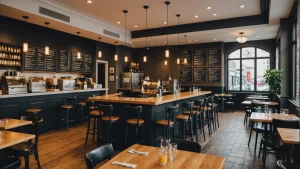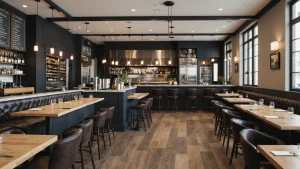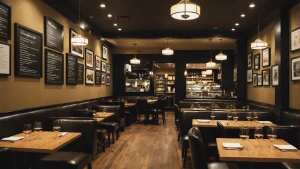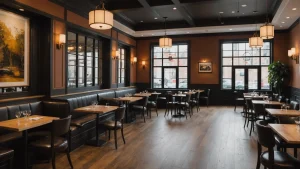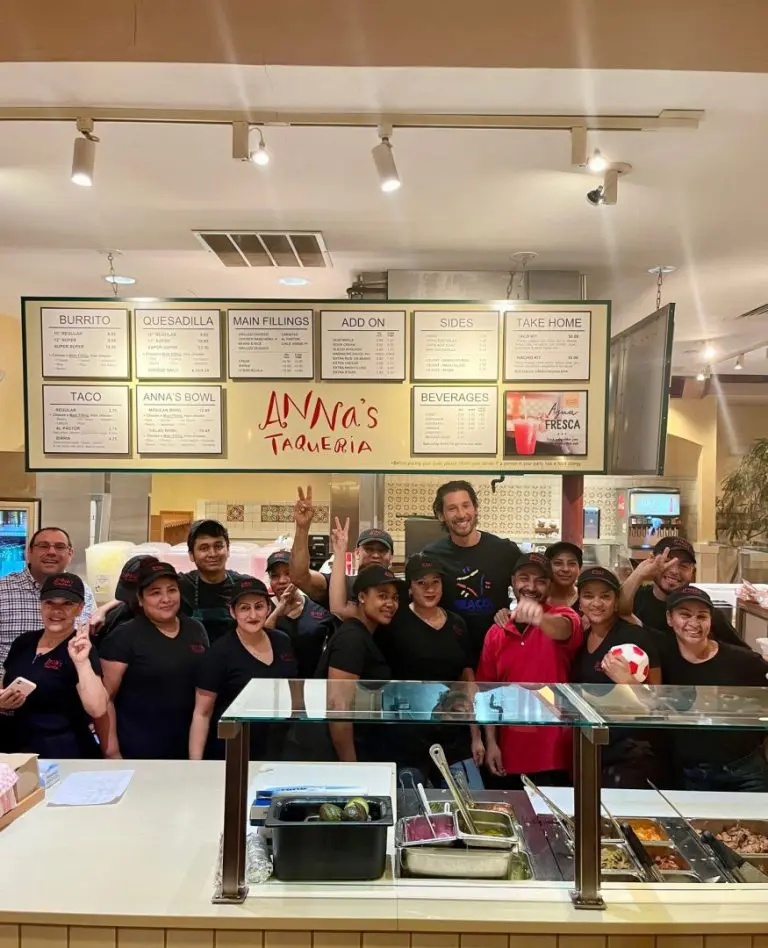60% of new restaurants close within their first year. 80% don’t make it past five. Why do restaurants fail?
The restaurant industry is notoriously challenging, with razor-thin, low profit margins, and fierce competition. In 2024, the landscape is more complex than ever.
So, what separates the thriving eateries from the shuttered storefronts?
In this guide, we’ll dive into the top 12 mistakes that can sink a restaurant – and how to avoid them. These pitfalls can sneak up on even the most seasoned restaurateurs, from poor financial management to inconsistent quality.
But don’t despair. We’ll also explore proven strategies for long-term success, like embracing technology, diversifying revenue streams, and building a strong team culture.
Whether you’re a first-time owner or a veteran chef, this article will give you the insights you need to beat the odds and build a resilient, profitable, successful restaurant owner and business.
Let’s get started.
Average Failure Rates
The National Restaurant Association estimates a 30% failure rate in the restaurant industry. The National Restaurant Association also reports that around 60% of new restaurants fail within the first year, and nearly 80% cease operations before reaching their fifth anniversary. The National Restaurant Association estimates a 20% success rate for all restaurants.

27% higher customer satisfaction
Professional delivery features:
- Real-time GPS tracking
- Automated ETA updates
- Delivery confirmation photos
- 27% higher delivery satisfaction
Top 12 Reasons Why Do Restaurants Fail
Poor financial management and lack of clear concepts are major contributors to restaurant failure
Inconsistent food quality, ineffective marketing, and high employee turnover also play significant roles
Restaurants that fail to adapt to challenges and underestimate competition are more likely to struggle
Poor Financial Management and Planning
One of the primary reasons restaurants fail is due to poor financial management and planning. Many restaurateurs enter the industry with a passion for food but lack the necessary business acumen to ensure long-term success. Failing to create and adhere to a realistic budget can quickly lead to overspending on decor, equipment, or inventory. Without proper cost control measures in place for high food costs, restaurants can find themselves in a precarious financial situation. Understanding the essential components of a successful restaurant business plan can equip owners with the right tools to manage finances effectively and avoid common pitfalls.
Effective financial planning involves regularly monitoring cash flow, and operating costs, understanding profit margins, and making data-driven decisions. Restaurant owners must also be prepared for unexpected expenses and have contingency funds to weather storms. Seeking the advice of a financial professional or mentor with industry experience can help restaurateurs navigate the complex world of restaurant finances. According to the Small Business Administration, proper financial planning is crucial for small businesses, including restaurants, to succeed.
High labor costs:
Businesses lose about 20% of sales due to poor inventory and staff management
Inconsistent Food Quality and Service
Consistency is key in the restaurant industry. Customers expect to receive the same high-quality food and service each time they visit an establishment. Failure to maintain these standards across all dishes can quickly lead to a decline in repeat business and negative word-of-mouth.
Inadequate staff training and supervision are often at the root of inconsistent food quality and service. Restaurant owners must invest time and resources into properly training their team, ensuring they understand recipes, plating techniques, and service standards. Regular quality checks and customer feedback should be used to identify areas for improvement and address any issues promptly. The National Restaurant Association emphasizes the importance of staff training and development to ensure consistent quality and customer satisfaction.
Lack of Clear Concept and Target Market
Restaurants that try to appeal to everyone often end up appealing to no one. A clear concept and a well-defined target market are essential for success in the competitive restaurant landscape. Without a strong brand identity, restaurants can struggle to differentiate themselves from competitors and attract loyal customers.
Before opening a restaurant, owners must thoroughly research their target demographic and develop a concept that resonates with that audience. This includes everything from the menu and the menu pricing, to the decor and atmosphere. Consistency in branding across all touchpoints, from the website to the dining room, helps create a cohesive experience that draws customers in and keeps them coming back.
Poor Location and Visibility
Choosing the right location is crucial for a restaurant’s success. A site with low foot traffic or limited accessibility can make it difficult to attract customers, even with a strong concept and excellent food. Before signing a lease, restaurateurs must thoroughly research the area, considering factors such as demographics, competition, and future development plans.
Visibility is also key, as most restaurants rely heavily on impulse visits and walk-in traffic. Signage, storefront design, and even the presence of outdoor seating can all impact a restaurant’s visibility and attract potential customers. In today’s digital age, online visibility is equally important, with many diners turning to search engines and review sites to discover new restaurants.
Poor location:
55% of diners decide where to eat based on location
Ineffective Marketing and Promotion
In the highly competitive restaurant industry, simply opening the doors is not enough to ensure success. Effective marketing and promotion are essential for attracting customers and building a loyal following. Many restaurants struggle due to a lack of online presence and engagement with their own local business community.
Social media platforms like Instagram and Facebook provide powerful tools for restaurants to showcase their dishes, share their story, and connect with potential customers. Regularly updating profiles with high-quality photos, engaging content, and special promotions can help build buzz and drive traffic. Partnering with local influencers, participating in community events, and collaborating with other businesses can also help increase visibility and establish the restaurant as a integral part of the local dining scene. Tools like Source AI can help restaurants generate engaging content and automate their social media presence.
Weak marketing strategy
A recent Dining Trends data analysis shows that 41% of customers research a restaurant's social media before choosing it. Meanwhile, four out of every seven Gen Zs in the US have visited a new restaurant based purely on favorable online reviews.
Marketing Strategy Effectiveness
Social Media High
Email Marketing Medium
Local Partnerships High
So, what is the #1 reason restaurants fail? While there are many contributing factors, poor financial management, and planning are often cited as the primary culprit.
In a study by Ohio State University, 60% of restaurants that closed cited economic factors as the reason for their failure.
However, it’s important to note that many of the other issues discussed, such as inconsistent quality and ineffective marketing, can also stem from a lack of financial resources and planning.
By understanding and addressing these common pitfalls, aspiring restaurateurs can increase their chances of success in this challenging but rewarding industry. In the next section, we’ll explore strategies for overcoming these obstacles and thriving in the competitive world of restaurants.

Metrobi is transforming catering deliveries
Specialized solutions for catering businesses:
- Catering-trained drivers
- Proper handling equipment
- Peak day delivery support
- 23% average cost reduction
How to Overcome Common Restaurant Industry Challenges
Embrace technology to streamline operations and enhance customer experience
Diversify revenue streams by expanding offerings and exploring new concepts
Prioritize staff well-being, development, and retention to build a strong team
Embrace Technology for Efficiency and Convenience
In today’s fast-paced world, restaurants must adapt to changing customer expectations and market demands. Implementing technology solutions can significantly improve operational efficiency and provide a seamless dining experience. Online ordering, reservations, and contactless payment options have become essential in the post-pandemic era. As Chris Comparato, CEO of Toast, states, “Restaurants that have embraced technology are seeing an increase in sales, improved guest satisfaction, and better staff retention”. Explore the concept of Revenue Per Available Seat Hour (RevPASH) to further enhance your establishment’s efficiency and bottom line. Delve into this essential metric to understand its impact on your restaurant’s earnings and customer service levels.
Lack of technology use
Seven out of 10 restaurants implemented QR codes during the pandemic. And 97% of restaurants use at least one online ordering platform in running business operations. Not investing in technology like digital menu apps, restaurant tools, and POS integrations hinders your restaurant from streamlining your business operations.
Utilizing point-of-sale (POS) and inventory management software can help restaurant owners track sales, manage costs, and optimize inventory levels.
According to a study by TouchBistro, restaurants that use POS systems report a 30% increase in sales and a 23% reduction in food waste.
These tools provide valuable insights into menu performance, allowing restaurateurs to make data-driven decisions and adjust their offerings accordingly.
Case Study: Sweetgreen’s Digital Transformation
Salad chain Sweetgreen has successfully leveraged technology to enhance its operations and customer experience. By investing in a mobile app, online ordering, and a robust loyalty program, Sweetgreen has seen a significant increase in digital sales. CEO Jonathan Neman notes, “Our digital channels have been a key driver of growth, accounting for over 50% of our total revenue”.
Diversify Revenue Streams and Offerings
Relying solely on dine-in sales can leave restaurants vulnerable to market fluctuations and unexpected challenges. Diversifying revenue streams and expanding offerings can help mitigate risks and attract new customers. Consider adding catering services, meal kits, grocery items, or cooking classes to your business model. These additional revenue sources can provide a financial cushion during slow periods and help you reach a wider audience.
Ghost kitchens and virtual brands have also gained popularity in recent years, allowing restaurants to operate multiple concepts from a single kitchen. As Michael Schaefer, Global Lead Food & Beverage at Euromonitor International, explains, “Ghost kitchens offer restaurants the opportunity to experiment with new concepts and reach new customers without the high upfront costs of opening a traditional brick-and-mortar location”.
Poor inventory and staff management
Studies show that due to poor inventory and staff management, businesses lose about 20% of sales due to theft, spilled drinks, and unrecorded expenses.
Unreasonable menu pricing
According to a 2024 TouchBistro report, 45% of Americans, 47% of Canadians, and 35% of Boomers say that menu price hikes impact their ordering decisions in a restaurant.
Prioritize Staff Well-being and Development
The restaurant industry is notorious for high turnover rates, which can lead to inconsistent service quality and increased training costs. To combat this issue, both restaurant management and owners must prioritize staff well-being and development. Providing competitive wages, benefits, and perks can help attract and retain top talent. Investing in ongoing training, mentorship, and career path programs can also foster a sense of loyalty and engagement among employees.
As Danny Meyer, CEO of Union Square Hospitality Group, notes, “The most successful restaurants are those that prioritize their staff’s well-being and growth. When you create a positive work environment and invest in your team’s development, they will, in turn, provide exceptional service to your guests”.
High quit rates:
In May 2021, the rate of quits per share of employment in the accommodation and food services sector, which includes restaurants, was 5.7%
Reasons for quitting:
The majority of respondents (77%) stated that they were leaving their jobs due to low wages and tips
Case Study: Shake Shack’s Employee Development Program
Fast-casual chain Shake Shack has implemented a comprehensive employee development program called “The Shacksperience.” This program focuses on training, mentorship, and career advancement opportunities for team members at all levels. As a result, Shake Shack has seen increased employee retention and customer satisfaction scores.
Optimize Menu Engineering and Inventory Management
Effective menu engineering and inventory management are crucial for maximizing profitability and minimizing waste. Regularly analyzing dish profitability and popularity can help restaurateurs refine their menus, highlighting high-margin menu items and removing underperforming ones. Establishing par levels and implementing just-in-time ordering of supplies can also help reduce food waste and improve cash flow.
As Chef and restaurateur Tom Colicchio advises, “Menu engineering is not a one-time exercise. It’s an ongoing process that requires constant monitoring and adjustment. By regularly reviewing your menu’s performance and making data-driven decisions, you can optimize your offerings and boost your bottom line”.
Strengthen Local Partnerships and Community Ties
Building strong relationships with local farmers, suppliers, and other businesses can help restaurants source high-quality ingredients, keep food costs low, support the local economy, and differentiate themselves from competitors. Participating in charity events and neighborhood associations can also help foster a sense of community and generate positive word-of-mouth.
As Alice Waters, chef and owner of Chez Panisse, states, “Restaurants have the power to shape their communities and support local food systems. By partnering with local farmers and businesses, we can create a more sustainable and resilient industry”.
The restaurant industry faces numerous challenges, but by embracing technology, diversifying revenue streams, prioritizing staff well-being, optimizing menu engineering, and strengthening local partnerships, restaurateurs can position themselves for long-term success. As the industry continues to evolve, adaptability and innovation will be key to overcoming obstacles and thriving in the face of adversity. Discover the essentials of franchising a restaurant in our comprehensive guide, complete with step-by-step instructions to ensure your expansion is both successful and sustainable.
Key Factors for Long-term Restaurant Success
Strong Financial Fundamentals and Monitoring
Successful restaurants prioritize financial discipline from day one. This involves creating detailed budgets, maintaining accurate accounting records, and conducting regular profit and loss (P&L) reviews. By closely tracking revenue, costs, and cash flow, owners can make informed business decisions, and quickly address any issues before they become critical.
Reinvesting profits back into the business is crucial for long-term success. This may include upgrading equipment, refreshing decor, or expanding marketing efforts. Building cash reserves during profitable periods helps restaurants have enough money to weather inevitable lean times, such as seasonal lulls or economic downturns.
Avoiding the 90% Failure Rate
While the oft-cited statistic that 90% of restaurants fail within the first year is somewhat exaggerated, the failure rate is still significant. A study by Ohio State University found that 60% of restaurants do not survive past their first year, and 80% close within five years.
Poor financial management is a leading cause of restaurant failure. Common pitfalls include underestimating startup costs, mismanaging inventory, and failing to control labor costs and expenses. By establishing strong financial fundamentals from the outset and continuously monitoring key metrics, restaurants can greatly improve their chances of long-term success. Looking for help with your financial strategy? Delve into our collection of free templates for restaurant business plans to lay a solid foundation for your dining establishment.
Consistent Execution of Food, Service, and Atmosphere
Delivering a consistently exceptional guest experience is paramount for building a loyal customer base. This starts with well-documented recipes and standard operating procedures (SOPs) to ensure food quality and presentation are maintained across all shifts and locations. Struggling to create a space that supports outstanding service? Discover how to craft an optimal restaurant layout plan that bolsters guest satisfaction and streamline operations.
Regular staff training, feedback, and performance incentives are essential for upholding service standards. Investing in employee development not only enhances the guest experience but also reduces costly turnover.
Creating a memorable atmosphere through thoughtful design, lighting, music, and decor is equally important. The ambiance should align with the restaurant’s concept and target audience, transporting guests to a desired emotional state.
Effective Leadership and Team Development
Strong leadership is the foundation of any successful restaurant. Owners and managers must clearly communicate their vision, values, and goals to rally the team around a shared purpose. Leading by example and demonstrating a genuine passion for hospitality inspires staff to deliver their best.
Empowering employees at all levels fosters a culture of ownership and accountability. When staff feel valued and trusted to make decisions, they are more engaged and motivated to exceed guest expectations. Recognizing and rewarding outstanding performance, both financially and through career advancement opportunities, helps retain top talent.
The High Cost of Employee Turnover
Turnover Rates
According to the National Restaurant Association, the average turnover rate in the restaurant industry is 75%, with some estimates as high as 150%. The cost of replacing an hourly employee failing restaurant, is estimated at $5,864, while replacing a manager can cost up to $14,036.
By prioritizing employee satisfaction and development, restaurants can significantly reduce turnover costs and cultivate a dedicated team that delivers consistent, high-quality experiences.
Memorable Guest Experiences and Relationships
In today’s competitive landscape, creating memorable guest experiences is key to building brand loyalty and driving repeat business. This involves going beyond basic service to anticipate and exceed guest needs, personalizing interactions, and creating emotional connections.
Implementing a robust customer relationship management (CRM) system allows restaurants to track guest preferences, tailor marketing communications, and offer targeted loyalty programs and perks. Promptly addressing feedback and proactively managing online reputation demonstrates a commitment to customer satisfaction.
When service failures occur, having a well-defined recovery process is crucial. Empowering staff to resolve issues on the spot, offering sincere apologies, and providing appropriate compensation can turn negative experiences into opportunities to strengthen guest relationships.
Agility in Adapting to Trends and Challenges
The restaurant industry is constantly evolving, with new trends, technologies, and challenges emerging at a rapid pace. Successful restaurants embrace a culture of continuous improvement and innovation across all aspects of their business.
Regularly reviewing and updating menus keeps offerings fresh and aligned with changing consumer preferences. Incorporating seasonal ingredients into menu prices, experimenting with global flavors, and offering healthier options can attract new audiences while keeping regulars engaged.
Flexibility in service model and marketing tactics is also essential. The COVID-19 pandemic highlighted the importance of quickly adapting to off-premise dining, online ordering, and digital marketing channels. Restaurants that were able to pivot and meet changing consumer needs were better positioned to survive and even thrive during challenging times.
Staying agile also means proactively addressing potential threats and seizing new opportunities. This may involve negotiating better lease terms, exploring new revenue streams (e.g., catering, retail products), or investing in technology to streamline operations and enhance the guest experience.
By continuously monitoring industry trends, seeking guest feedback, and fostering a culture of innovation, restaurants can stay ahead of the curve and adapt to the ever-changing landscape.
Average Lifespan of a New Restaurant
Opening a new restaurant is an exciting venture, but it’s important to understand the challenges that come with it. According to the National Restaurant Association, approximately 60% of restaurants fail within their first year of operation. This alarming statistic highlights the need for thorough planning and adequate funding before launching a new eatery. Interested in avoiding common pitfalls by implementing a restaurant soft launch? Discover effective strategies for planning a successful soft opening of your restaurant.
60% Fail Within the First Year of Operation
Many new restaurants struggle to make it through their first year due to a combination of factors. Poor planning and undercapitalization are among the most common reasons for early failure. Opening a restaurant requires significant upfront costs, including rent, equipment, inventory, and staff salaries. Without sufficient capital to cover these expenses, restaurants can quickly find themselves in financial trouble. Learn how to successfully open a new restaurant by thoroughly understanding the initial investments and drafting a detailed strategy to cover costs and generate profits.
Additionally, new restaurants often struggle to generate enough sales and build a loyal customer base within their first year. This can be due to a variety of factors, such as:
Intense competition in the local market
Ineffective marketing and promotion
Inconsistent food quality or service
Lack of a unique selling proposition
80% Fail Within the First 5 Years
Even restaurants that survive their first year face ongoing challenges. According to the National Restaurant Association, about 80% of restaurants fail within their first five years of operation. This is often due to a combination of the factors mentioned above, as well as:
Failure to consistently break even and become firmly established
Difficulty adapting to changing consumer preferences and trends
Burnout among owners and staff due to long hours and high stress
Rising costs of ingredients, labor, and rent
To beat these odds, restaurant owners must remain vigilant and proactive. As noted in the restaurant industry, “Restaurants are a business, and you have to treat it like a business. You have to be present, you have to be on top of your game, and you have to be consistent.”
Successful restaurants are those that can adapt to challenges, maintain a strong brand identity, and consistently deliver quality food and service. By understanding the common pitfalls that lead to restaurant failure, owners can take steps to mitigate these risks and set themselves up for long-term success.
Your Restaurant’s Success Is in Your Hands
Opening and running a successful restaurant in 2024 requires careful planning, consistent execution, and the ability to adapt to challenges. By understanding the common pitfalls and implementing proven strategies, you can increase your chances of long-term success. Uncover the critical steps to launch a restaurant, encompassing everything from developing an impactful business strategy to obtaining financial support and selecting an ideal site.
Focus on building a strong financial foundation, maintaining high standards of food and service, and creating a positive work environment for your team. Embrace technology, diversify your offerings, and cultivate meaningful relationships with your customers and community.
What’s one action you can take today to strengthen your restaurant’s resilience and competitiveness? Whether it’s reviewing your financial metrics, training your staff, or engaging with your guests, every small step counts.
Stay committed to your vision, stay agile in your approach, and never stop learning and improving. With dedication and adaptability, you can beat the odds and create a thriving, memorable restaurant that stands the test of time.




